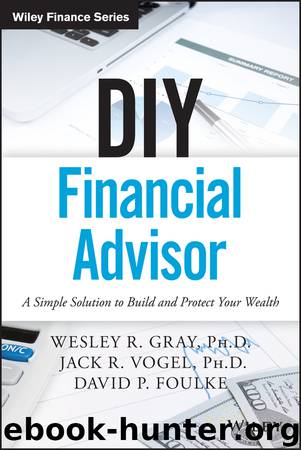DIY Financial Advisor by Wesley R. Gray & Jack R. Vogel & David P. Foulke

Author:Wesley R. Gray & Jack R. Vogel & David P. Foulke
Language: eng
Format: epub
ISBN: 9781119124900
Publisher: Wiley
Published: 2015-08-17T00:00:00+00:00
At first glance, this appears to be a pretty wide-ranging list of asset classes, and in scrutinizing the individual categories, it seems several might be downright unavailable for the average investor. For example, private equity, an asset class famous for high fees, illiquidity, and variable performance, would be pretty tough to implement in our retirement portfolio if we stick to the FACTS. Yale, however, with a dedicated staff, significant negotiating leverage, and decades of experience, can probably pull it off. In fact, private equity is Yale's largest asset allocation! And what about investments in additional esoteric areas—say, timber assets? Investing in tangible natural resources presents numerous challenges for investors like us (unless of course, you manage millions of acres of forest land in your spare time). In short, the complexity of several investments can quickly outweigh their potential return. If you, like Yale, can manage incremental complexity, be sure you are getting the return you deserve.
For the rest of us, we need to rely on more simple approaches. As E. F. Schumacher points out, “Any third-rate engineer or researcher can increase complexity; but it takes a certain flair of real insight to make things simple again.”4 We concur with Schumacher's insight that it is not always easy to make things simpler, especially when it comes to investing. Simplicity requires the discipline of not falling victim to the idea that complexity and activity necessarily add value. Adding bells and whistles is fun, and nobody wants to sit around and “do nothing.”
A great example of a simple, do-nothing trade is Van Hoisington's 30-year zero-coupon bond trade—buy-and-hold. Van described his trading activity, or more accurately the lack thereof, at the October 2012 Grant's Interest Rate Observer Conference, in this way, “I don't do anything and I don't know anything.” Van's willingness to do nothing and courage to admit he knows nothing, are two of the greatest traits of the best investors. And while we don't recommend Van's advice, Van has done extremely well with his long-term zero-coupon Treasury bond trade over the past 20-plus years, which highlights that an investor doesn't need to engage in activity to be successful. Less is sometimes more.
Similarly, individual investors should accept their own limitations and not feel compelled to invest exactly how Yale invests. Your objectives likely aren't those of Yale's, your tolerance for risk isn't the same, and you probably have a different time horizon. We recommend investors consider a reduced number of asset classes, focusing on those that are easy to manage, easy to invest in, and provide the lion's share of the benefits that accompany a much greater degree of diversification.
In our approach, identify three target assets and map the corresponding allocations from Yale's model into our simple framework. The one asset class we do not cover is the so-called absolute return asset class. Roughly translated, this means “expensive, opaque, and tax-inefficient hedge funds,” so we exclude this allocation from our opportunity set. The three asset classes are:
Equity: This includes the common stocks of
Download
This site does not store any files on its server. We only index and link to content provided by other sites. Please contact the content providers to delete copyright contents if any and email us, we'll remove relevant links or contents immediately.
The Black Swan by Nassim Nicholas Taleb(6762)
Bad Blood by John Carreyrou(6274)
Pioneering Portfolio Management by David F. Swensen(6078)
Millionaire: The Philanderer, Gambler, and Duelist Who Invented Modern Finance by Janet Gleeson(4092)
Skin in the Game by Nassim Nicholas Taleb(3965)
The Money Culture by Michael Lewis(3843)
Bullshit Jobs by David Graeber(3826)
Skin in the Game: Hidden Asymmetries in Daily Life by Nassim Nicholas Taleb(3720)
The Wisdom of Finance by Mihir Desai(3523)
Blockchain Basics by Daniel Drescher(3327)
Liar's Poker by Michael Lewis(3220)
The Intelligent Investor by Benjamin Graham Jason Zweig(2930)
Hands-On Machine Learning for Algorithmic Trading by Stefan Jansen(2925)
Mastering Bitcoin: Programming the Open Blockchain by Andreas M. Antonopoulos(2890)
Fooled by Randomness: The Hidden Role of Chance in Life and in the Markets by Nassim Nicholas Taleb(2860)
Investing For Dummies by Eric Tyson(2791)
The Power of Broke by Daymond John(2769)
Market Wizards by Jack D. Schwager(2538)
Zero Hour by Harry S. Dent Jr. & Andrew Pancholi(2531)
